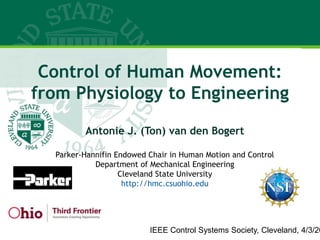
Control of Human Movement from Physiology to Engineering
- 1. Control of Human Movement: from Physiology to Engineering Antonie J. (Ton) van den Bogert Parker-Hannifin Endowed Chair in Human Motion and Control Department of Mechanical Engineering Cleveland State University http://hmc.csuohio.edu IEEE Control Systems Society, Cleveland, 4/3/20
- 2. Cost of transport (COT) distancexweight usednergye COT COT = 0.2 COT = 3.0 Non-human movement: Honda Asimo
- 3. Petman (Boston Dynamics) cost of transport unknown -- designed for tethered operation
- 4. Big Dog (Boston Dynamics) 3 MPG 340 MPG hydraulic actuators powered by internal combustion enging
- 5. Indego Exoskeleton (Parker-Hannifin) electric motors powered by rechargeable batteries
- 7. Humans and animals use 10-100 times less energy than machines perform much better than machines Why? What can engineers learn?
- 9. Structure of muscles 2 μm
- 10. Overlapping proteins in muscle fiber ADP actin filament myosin filament & myosin head (crossbridge) ATP ATP (adenosine tri-phosphate) is energy source of muscle contraction 10 nm stroke length
- 11. Control of muscle force Luigi Galvani (1737-1798) Hz Hz Hz Hz twitches fused tetanus Frequency-modulated pulse trains
- 12. Motor unit recruitment http://nmrc.bu.edu/tutorials/motor_units/ Motor unit: A set of muscle fibers that are controlled by the same motor neuron When force increases gradually, smallest motor units are recruited first
- 13. Spring-like mechanical properties fiber length force Control system needs to know that force is position-dependent
- 14. Velocity dependence of force Muscle (like any motor) has an optimal speed of operation typically about 0.3 m/s (depending on muscle architecture)
- 15. Muscles vs. electric motors Muscles 50 ms response time slower to turn off 20-25% efficiency low speed high torque "direct drive" Electric motors instantaneous response 90% efficiency high speed low torque requires gearbox for human-like applications
- 16. Feedback control Physiological sensors for motion control skin (stretch and pressure) inner ear (inertial sensors) muscles (stretch and force) Nerve conduction velocity is about 100 m/s Reflex loop delay 50 ms
- 17. Animals vs. machines Muscles slow (50 ms response time) inefficient (20-25% efficiency) inconsistent (fatigue, variability) Sensory system slow (50 ms signal delay) inconsistent Sprint running: foot is on the ground for only 100 ms! Why do humans and animals perform so well? mechanical design (anatomy) control (brain and spinal cord)
- 19. Muscles often cross multiple joints motor motor arm bones and muscles typical robotic design
- 20. 0 0.5 1 1.5 2 0 0.5 1 1.5 2 2.5 LENGTH FORCE passive 25% activated 50% activated 75% activated 100% activated Muscles are like springs • Nonlinear spring • Activation moves you to a different force-length curve isometric isotonic
- 22. This makes control easier and saves energy Muybridge, 1878
- 24. What about motors? Hanz Richter, CSU Robotics Lab: "Semiactive virtual control" Motors can transfer energy store energy
- 25. Energy-efficient robots courtesy of Sangbae Kim, MIT MIT Cheetah robot uses less energy than animal at same size and speed
- 26. Control (brain and spinal cord)
- 27. Hierarchical system Brain: 1011 neurons Spinal cord: 109 neurons ~10,000 PCs
- 28. Proportional-derivative control Seems to be used by humans for simple movements (reaching) Also known as Equilibrium point control (human motor control) Impedance control, compliance control (robotics) position force actuator with elastic properties or proportional control external load
- 29. Control of standing Proportional-derivative control works well for small perturbations ADRC works well also Larger perturbations require stepping move away from the desired posture! proportional control will never do that 𝐱 = 𝜃 𝑎𝑛𝑘 𝜃 𝑎𝑛𝑘 𝜃ℎ𝑖𝑝 𝜃ℎ𝑖𝑝 u = 𝑇𝑎𝑛𝑘 𝑇ℎ𝑖𝑝 = −𝐊2x4 𝐱
- 30. Walking is even more complex Nonlinear dynamics High-dimensional state space and control space Limit cycle Proportional control is not always "smart" enough 1650 RR uxu)f(x,x
- 31. Proportional-derivative control designed by linearization Muscles receive feedback from joint angles and angular velocit Simulation test Human response to tripping Do we need different control laws? Do we need additional sensors?
- 32. Identification of human control Human-based control: We "map" the control system of our volunteers, so we can copy it to a robotic system gain-scheduled PD control neural networks?
- 33. Virtual muscles Electric motors can behave and feel like real muscles motor motor = joint rotations joint torques
- 34. Summary Animals and humans can perform amazing movements more efficient than most robots Muscles and nerves inefficient, slow and sloppy Mechanical design is important can be virtualized with electric motors Control is important learn from human data
- 35. Thank You!
Editor's Notes
- These mechanisms have been especially well developed in horses. My PhD thesis was on horse limbs (see, it does not matter what your thesis is about). Because of these springs that cross multiple joint, you get a very interesting vibration spectrum. Here is a simulation of a forelimb with a big mass on top that represents part of the body. There is a natural frequency of about 1 Hz, which is the bounce of the limb during walking and running. But there is also a much higher transverse vibration frequency, about 30 Hz which I can excite by “plucking” the limb like a string. Here it is. These vibrations are actually visible in high-speed video, and you also see them in horizontal ground reaction force recordings. Robots, because of the way they are designed, do not have anything like this. Probably the designer does not like it.